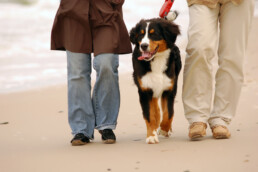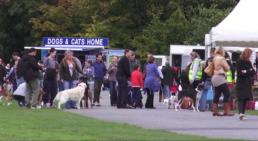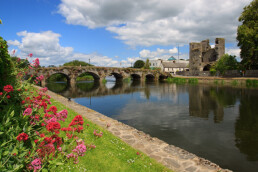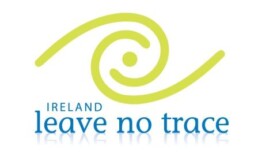Do I need to license my dog?
By law all dogs in Ireland over the age of 4 months must have a licence.
Dog licences are issued by post offices or local authorities. The revenue from them finances the operation of dog control services.
In order to obtain a dog licence, you must be over 16 years of age.
All dogs over 4 months of age must have a licence. Puppies under 4 months who are still with their mothers do not need licences but once they leave their mothers they must have a licence.
Your dog must be accompanied by and be under your effective control or the control of another responsible person if it is outside your home or premises or the home or premises of the person in charge of it.
A dog warden can ask you to produce evidence of your dog licence and failure to do so can result in an on the spot fine. Failure to pay this fine within a specified period can result in prosecution by the local authority.
If you arer found to have a dog with no dog licence then you will receive an on the spot fine of €30 payable to your local authority. If this fine is not paid it lead to prosecution in the District Court with a maximum fine of €1904.61 and/or 3 months imprisonment.
An individual dog licence costs €12.70 and is valid for one year.
Dog Friendly Beaches
The beaches in Ireland are great places to spend time with your dog. In many counties, dogs are welcome, as long as they are kept on a lead and you clean up after them. But you do need to be aware of rules when taking your dog onto a beach, as they vary from county to county.
Blue Flag Beach Rules Concerning Dogs
National laws concerning dogs are strictly enforced on all Blue Flag beaches. Their access and activities must under all circumstances be controlled. Dogs must be kept on a lead or under close control on all adjoining or abutting areas throughout the bathing season. Dog-owners are responsible for cleaning up after their dog. Dog refuse bins are generally provided. It is recommended that an area be provided for the public to exercise dogs and this should be clearly delineated. In areas with local byelaws or national legislation prohibiting the entrance of dogs on a Blue Flag beach in certain periods, this legislation must be followed.
Dog Friendly Beaches
Here are some dog friendly beaches to get you started.
Greystones Beach, Greystones, Co. Wicklow
Baxter at the DSPCA Doggy Day Out
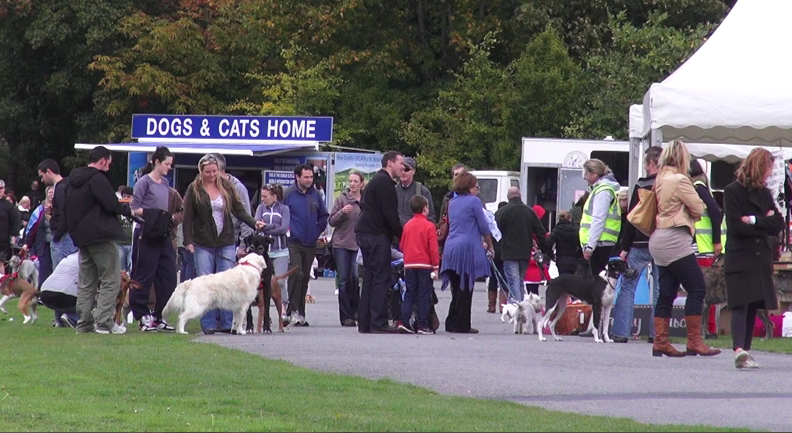
Marlay Park today.
There were plenty of events to choose from, such as ‘Scrufts’ the all-inclusive dog competition, to a demonstration from Dog Sled Ireland, from Dog Training Sessions with ‘King of Paws’ Alex Pitrelli, to doggy speed dating; this canine carnival had something for everyone. But the best part was getting together for a group photo of all the dogs and their owners.
The Dublin SPCA is Ireland’s oldest animal welfare organisation and every year it rescues, re-homes and cares for thousands of dogs through its centre in Rathfarnham and its mobile veterinary clinics. The DSPCA relies on charitable donations to keep its service in operation.
To read more about the DSPCA, please click here.
'Rules' of the Way: Walking Your Dog in the Wicklow Mountains
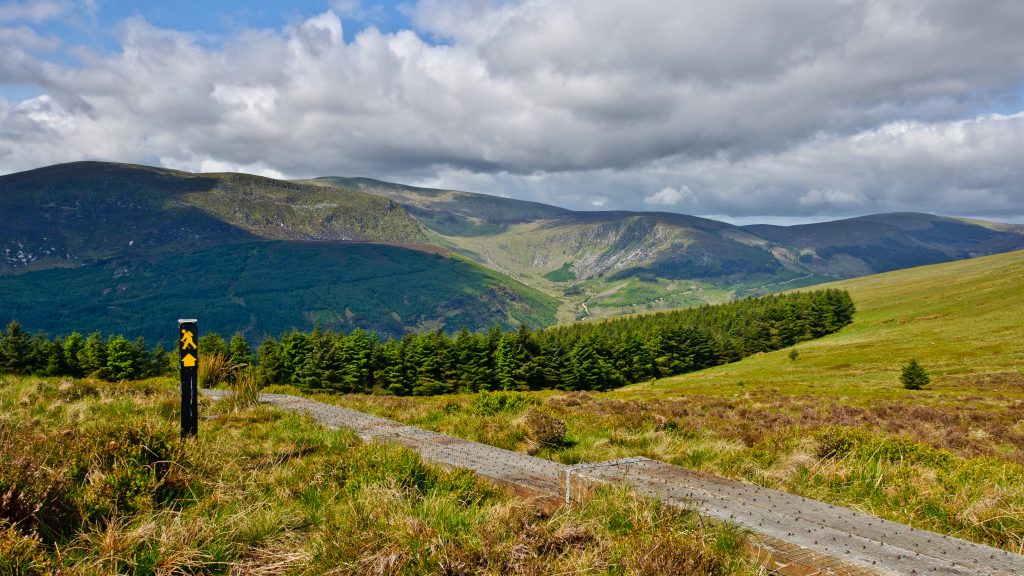
With over 20,000 hectares of spectacular upland scenery, The Wicklow Mountains National Park offers walkers a real sense of being in the wilderness. The National Park offers an open access policy allowing visitors to explore freely on foot. Which means it's important for dog owners to act responsibly.
If you plan on taking your dog with you, it's important to bear in mind the following four points when visiting the National Park.
- Is Your Dog Under Control?
Always carry a lead when walking with your dog in the National Park. The National Park is full of deer. Few dogs can resist the temptation to chase animals. Never let your dog out of your sight. Stressed farm animals can die. Be warned: Farmers in Ireland are entitled to shoot dogs that worry their livestock.
- Not Everyone Likes Dogs
Some people may be scared of dogs, especially children. Even the friendliest dog may worry small children. Few people appreciate being sniffed, jumped on or sprayed by water when a dog shakes itself. Be prepared to slip a lead on your dog when people approach.
- Beware of Cliffs!
Dogs are not equipped for steep ground. Unlike the mountain goats you may see in the National Park, dogs are not adept at leaping from rock to rock. Don't let your dog chase deer or goat. It could lead your dog to a cliff fall. Be warned: Mountain Rescue only rescue humans, not dogs!
- Pick Up After Your Dog
Our dog's are fed high quality food, which means the nutrients they bring can be detrimental to the habitat of the National Park. A deer eats heather, poops heather, feeds heather, etc. Visiting dogs can introduce pathogens in their faeces that can affect wildlife. Always carry a plastic bag or poop scoop and pick up after your dog.
You can read more about taking your dog for a walk in the Wicklow Mountains National Park here.
Useful links:
Overview of the Wicklow Way Trail
The Barrow Way, Co. Carlow
Rising in the Slieve Bloom Mountains in the southern midlands, and joining the rivers Nore and Suir, before flowing into the Celtic Sea at Waterford Harbour, the River Barrow lays claim to being the second longest river in Ireland.
First made navigable in the eighteenth century, the Barrow stretches for 114km from the canal hamlet of Lowtown in County Kildare to the beautiful monastic site and village of St Mullins in south County Carlow.
With its peaceful route through a quiet landscape, a constantly expanding river for company, and grassy towpaths, tracks and quiet roads, the Barrow Way is perhaps one of the most peaceful walks in Ireland.
Type of Walk: National Waymarked Trail
Level of Difficulty: An easy walk
Length: 100km
Start Grid Point: N 790 250
Finish Grid Point: S 728 378
Ordnance Survey Map: OSI Discovery Series Sheets 49, 55, 61 and 68
You can read more about walking The Barrow Way at Irishtrails.ie.
'Walkers Welcome' in Coillte's Forest Trails
Not all land owners welcome recreation users onto their land. This can be for a variety of reasons, privacy, safety, conservation, protection of life stock or crops etc. However Coillte welcomes responsible users who practice 'Leave No Trace' and allows permissive access for walkers to its estate of over 1,000,000 acres.
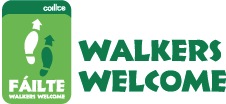 Forests are a great place to walk with your dog. Many of Coillte's forest lands are in some of Ireland's most beautiful locations. To help you with knowing where access is allowed to walkers, Coillte are posting "Walkers Welcome" signs at the entrances to their forests, so you are free to go in when you see this sign.
Forests are a great place to walk with your dog. Many of Coillte's forest lands are in some of Ireland's most beautiful locations. To help you with knowing where access is allowed to walkers, Coillte are posting "Walkers Welcome" signs at the entrances to their forests, so you are free to go in when you see this sign.
Over the coming months, we're going to be featuring some of Coiltte's forest walks here on PetFriendlyIreland.
Leave No Trace
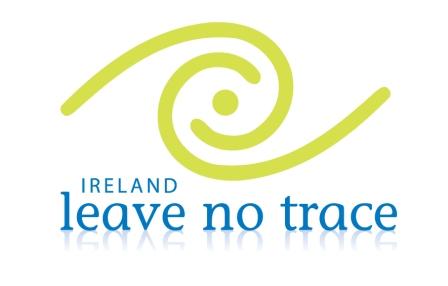 The mountain environment is a delicate one. By understanding how we impact on wildlife, landscapes and each other, we can modify our behaviour to ensure that we treat the land, animals and people within these environments with respect.
The mountain environment is a delicate one. By understanding how we impact on wildlife, landscapes and each other, we can modify our behaviour to ensure that we treat the land, animals and people within these environments with respect.
A number of Ireland’s National Parks are part of a nationwide programme called Leave No Trace. The Leave No Trace skills and ethics help visitors to the outdoors leave minimum impact while enjoying the National Parks.Leave No Trace principles are not regulations. They are guidelines to help visitors make informed decisions in the outdoors so that they may leave the area as beautiful and as natural as they found it.
The 7 principles of ‘Leave No Trace':
(1) Plan Ahead and Prepare
- Know the regulations and special concerns for the area that you’ll visit. The National Park Information office can advise on protected areas and seasonal concerns.
- Check if your chosen recreation or activity is permitted. Always follow signs.
- Check the weather forecast. Prepare for changeable weather and the possibility of something going wrong.
- Ensure you have the skills and equipment needed for your activity.
- If you are a group leader you have added responsibilities – know the competencies and expectations of your group.
For environmental, safety and social reasons split large parties into smaller groups less than 10, ideally between 4-6.
(2) Travel and Camp on Durable Surfaces
- Durable surfaces include established trails, rock, gravel, dry grass and snow.
- On eroded tracks keep to the centre of the track, even when wet and muddy, to avoid widening the erosion.
- In pristine areas:
- Disperse use to avoid creating new tracks
- Avoid areas where impacts are just beginning to show.
(3) Respect Wildlife
- Observe wildlife from a distance. Do not follow or approach them.
- Never feed animals. Feeding wildlife damages their health, alters natural behaviour and exposes them to predators and other dangers.
- Dogs should be kept under effective control – i.e. they should come at first call.
- Avoid wildlife during sensitive times: mating, nesting, raising young and winter.
(4) Leave What You Find
- Take care not to damage old walls, ruins, abandoned mine shafts and their workings.
- Leave rocks, plants, animals and other natural objects as you find them. Fallen trees and dead wood are valuable wildlife habitats – please do not remove or damage.
- Avoid introducing or transporting non-native species. E.g. wash down all boats to avoid introducing zebra mussel.
(5) Be Considerate of Others
- Park carefully – avoid blocking gateways and forest entrances. Remember that Park staff and the emergency services may need access at all times.
- Respect other visitors and the quality of their experience.
- Take rest breaks away from tracks.
Let natures sounds prevail; avoid loud noises.
(6) Dispose of Waste Properly
- “Leave No Waste” – remove all rubbish and leftover food items, even biodegradable items like T-bags and fruit peels.
- To wash yourself or your dishes, carry water 30m away from streams or lakes, use small amounts of biodegradable soaps if necessary. Scatter strained wastewater.
- Human waste should be buried or carried out depending on the soil type. Waterlogged soils impede the proper break down of waste. Human waste should be removed in these areas.
- To dispose of solid human waste, dig a “cathole” – a hole 10-12cm deep, located at least 30m away from watercourses and 50m from walking routes. Cover and disguise the hole when finished.
- All toilet paper and hygiene products should be carried out.
(7) Minimize the Effects of Fire
- Fire can be devastating to habitats and wildlife. Campfires are not currently permitted in the National Park; the issuing of permits for campfires is suspended pending review.
- Only gas barbeques are permitted within the National Park.
Download the Leave No Trace brochure here.
You can visit the Leave No Trace Ireland website at www.leavenotraceireland.org

